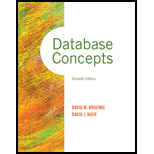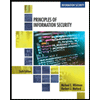
Database Concepts (7th Edition)
7th Edition
ISBN: 9780133544626
Author: David M. Kroenke, David J. Auer
Publisher: PEARSON
expand_more
expand_more
format_list_bulleted
Expert Solution & Answer
Chapter 6, Problem 6.17RQ
Explanation of Solution
Deadlock:
- Deadlock occurs when the requested data is being used by multiple users, this specifies that two or more users trying to access a data that is being currently utilized by some other user.
- It generally occurs in a situation when one is waiting for the resource for an indefinite period of time. But eventually, that resource is waiting for another event to occur. This problem is called as deadlock.
- It will occur when multiple transactions locked the same resources and each of the transaction is waiting for the unlocking moment of the resource.
There are two ways of managing deadlocks, which are as given below:
- The deadlock situation can be prevented once before it occurs or it can be resolved once it has occurred.
- The below indicates how the deadlock situation can be prevented and resolved in detail:
Deadlock Prevention:
- Deadlock can be prevented by making the user to request the locks that are necessary at a particular time such that it ensures that data is either accessed or it will be avoided completely.
- The access order of the resources is being set which ensures that the data requested will be available at the time of request...
Expert Solution & Answer
Want to see the full answer?
Check out a sample textbook solution
Students have asked these similar questions
using r language
show all the work
answer question 3
Chapter 6 Solutions
Database Concepts (7th Edition)
Ch. 6 - Prob. 6.1RQCh. 6 - Explain how database administration tasks vary...Ch. 6 - Prob. 6.3RQCh. 6 - Prob. 6.4RQCh. 6 - Prob. 6.5RQCh. 6 - Prob. 6.6RQCh. 6 - Prob. 6.8RQCh. 6 - Prob. 6.9RQCh. 6 - Prob. 6.10RQCh. 6 - Prob. 6.11RQ
Ch. 6 - Prob. 6.12RQCh. 6 - Prob. 6.13RQCh. 6 - Prob. 6.14RQCh. 6 - Prob. 6.15RQCh. 6 - Prob. 6.16RQCh. 6 - Prob. 6.17RQCh. 6 - Prob. 6.18RQCh. 6 - Explain the benefits of marking transaction...Ch. 6 - Explain the use of the SQL transaction control...Ch. 6 - Prob. 6.21RQCh. 6 - Describe statement-level consistency.Ch. 6 - Prob. 6.23RQCh. 6 - Prob. 6.24RQCh. 6 - Prob. 6.25RQCh. 6 - Prob. 6.26RQCh. 6 - Prob. 6.27RQCh. 6 - Explain what serializable isolation level is. Give...Ch. 6 - Explain the term cursor.Ch. 6 - Prob. 6.30RQCh. 6 - What is the advantage of using different types of...Ch. 6 - Explain forward-only cursors. Give an example of...Ch. 6 - Explain static cursors. Give an example of their...Ch. 6 - Prob. 6.34RQCh. 6 - Prob. 6.36RQCh. 6 - Prob. 6.37RQCh. 6 - Describe the advantages and disadvantages of...Ch. 6 - Prob. 6.40RQCh. 6 - Prob. 6.41RQCh. 6 - Prob. 6.42RQCh. 6 - Prob. 6.44RQCh. 6 - Prob. 6.45RQCh. 6 - What is the advantage of making frequent...Ch. 6 - Summarize a DBAs responsibilities for managing...Ch. 6 - Prob. 6.48RQCh. 6 - Prob. 6.49RQCh. 6 - Prob. 6.50E
Knowledge Booster
Similar questions
- List down the strenghts and weaknesses of your team project for Capsim Simulation? Explan.arrow_forwardCapsim Team PowerPoint Presentations - Slide Title: Key LearningsWhat were the key learnings that you discovered as a team through your Capsim simulation?arrow_forwardWrite the SQL code that permits to implement the tables: Student and Transcript. NB: Add the constraints on the attributes – keys and other.arrow_forward
- Draw an ERD that will involve the entity types: Professor, Student, Department and Course. Be sure to add relationship types, key attributes, attributes and multiplicity on the ERD.arrow_forwardDraw an ERD that represents a book in a library system. Be sure to add relationship types, key attributes, attributes and multiplicity on the ERD.arrow_forward2:21 m Ο 21% AlmaNet WE ARE HIRING Experienced Freshers Salesforce Platform Developer APPLY NOW SEND YOUR CV: Email: hr.almanet@gmail.com Contact: +91 6264643660 Visit: www.almanet.in Locations: India, USA, UK, Vietnam (Remote & Hybrid Options Available)arrow_forward
- Provide a detailed explanation of the architecture on the diagramarrow_forwardhello please explain the architecture in the diagram below. thanks youarrow_forwardComplete the JavaScript function addPixels () to calculate the sum of pixelAmount and the given element's cssProperty value, and return the new "px" value. Ex: If helloElem's width is 150px, then calling addPixels (hello Elem, "width", 50) should return 150px + 50px = "200px". SHOW EXPECTED HTML JavaScript 1 function addPixels (element, cssProperty, pixelAmount) { 2 3 /* Your solution goes here *1 4 } 5 6 const helloElem = document.querySelector("# helloMessage"); 7 const newVal = addPixels (helloElem, "width", 50); 8 helloElem.style.setProperty("width", newVal); [arrow_forward
arrow_back_ios
SEE MORE QUESTIONS
arrow_forward_ios
Recommended textbooks for you
 Database Systems: Design, Implementation, & Manag...Computer ScienceISBN:9781305627482Author:Carlos Coronel, Steven MorrisPublisher:Cengage Learning
Database Systems: Design, Implementation, & Manag...Computer ScienceISBN:9781305627482Author:Carlos Coronel, Steven MorrisPublisher:Cengage Learning Database Systems: Design, Implementation, & Manag...Computer ScienceISBN:9781285196145Author:Steven, Steven Morris, Carlos Coronel, Carlos, Coronel, Carlos; Morris, Carlos Coronel and Steven Morris, Carlos Coronel; Steven Morris, Steven Morris; Carlos CoronelPublisher:Cengage Learning
Database Systems: Design, Implementation, & Manag...Computer ScienceISBN:9781285196145Author:Steven, Steven Morris, Carlos Coronel, Carlos, Coronel, Carlos; Morris, Carlos Coronel and Steven Morris, Carlos Coronel; Steven Morris, Steven Morris; Carlos CoronelPublisher:Cengage Learning Management Of Information SecurityComputer ScienceISBN:9781337405713Author:WHITMAN, Michael.Publisher:Cengage Learning,
Management Of Information SecurityComputer ScienceISBN:9781337405713Author:WHITMAN, Michael.Publisher:Cengage Learning, Principles of Information Security (MindTap Cours...Computer ScienceISBN:9781337102063Author:Michael E. Whitman, Herbert J. MattordPublisher:Cengage Learning
Principles of Information Security (MindTap Cours...Computer ScienceISBN:9781337102063Author:Michael E. Whitman, Herbert J. MattordPublisher:Cengage Learning Principles of Information Systems (MindTap Course...Computer ScienceISBN:9781305971776Author:Ralph Stair, George ReynoldsPublisher:Cengage Learning
Principles of Information Systems (MindTap Course...Computer ScienceISBN:9781305971776Author:Ralph Stair, George ReynoldsPublisher:Cengage Learning Fundamentals of Information SystemsComputer ScienceISBN:9781337097536Author:Ralph Stair, George ReynoldsPublisher:Cengage Learning
Fundamentals of Information SystemsComputer ScienceISBN:9781337097536Author:Ralph Stair, George ReynoldsPublisher:Cengage Learning

Database Systems: Design, Implementation, & Manag...
Computer Science
ISBN:9781305627482
Author:Carlos Coronel, Steven Morris
Publisher:Cengage Learning

Database Systems: Design, Implementation, & Manag...
Computer Science
ISBN:9781285196145
Author:Steven, Steven Morris, Carlos Coronel, Carlos, Coronel, Carlos; Morris, Carlos Coronel and Steven Morris, Carlos Coronel; Steven Morris, Steven Morris; Carlos Coronel
Publisher:Cengage Learning

Management Of Information Security
Computer Science
ISBN:9781337405713
Author:WHITMAN, Michael.
Publisher:Cengage Learning,

Principles of Information Security (MindTap Cours...
Computer Science
ISBN:9781337102063
Author:Michael E. Whitman, Herbert J. Mattord
Publisher:Cengage Learning

Principles of Information Systems (MindTap Course...
Computer Science
ISBN:9781305971776
Author:Ralph Stair, George Reynolds
Publisher:Cengage Learning

Fundamentals of Information Systems
Computer Science
ISBN:9781337097536
Author:Ralph Stair, George Reynolds
Publisher:Cengage Learning